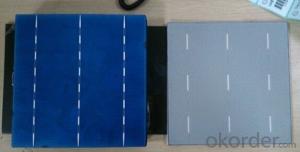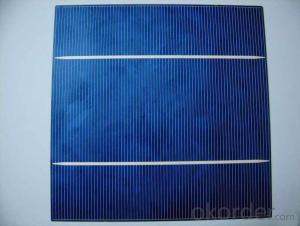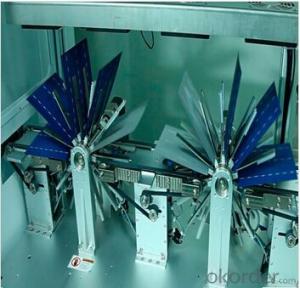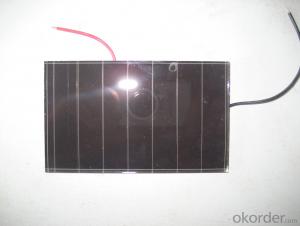Mono Solar Cells156mm*156mm in Bulk Quantity Low Price Stock 18.4
- Loading Port:
- Shanghai
- Payment Terms:
- TT OR LC
- Min Order Qty:
- 1000 pc
- Supply Capability:
- 100000 pc/month
OKorder Service Pledge
OKorder Financial Service
You Might Also Like
Brief Introduction
- Up to 20.0% efficiency, one of the highest performing mono crystalline cells on the market
- Three bus bars boosts current collection over the entire cell area, leading to higher fill factors
- Blue anti-reflecting coating allows more sunlight be captured and converted to electricity
- Finer, closer fingers improves charge collections for improved energy yield
- Lower light-induced degradation leads to greater power output over the entire module lifetime
- All solar cells are tightly classified to optimize output of module
- Maximum yield and longevity due to hotspot prevention
- Premium appearance results in a highly uniform and aesthetically appealing module
Specification
- Product Mono-crystalline silicon solar cell
- Dimension 156 mm x 156 mm ± 0.5 mm
- Thickness 200 μm ± 30 μm
- Front 1.5 ± 0.1 mm busbar (silver)
- Silicon nitride antireflection coating
- Back 3.0 mm continuous soldering pads (silver)
- Back surface field (aluminum)
Electric performance parameters

- Testing conditions: 1000 W/m2, AM 1.5, 25 °C, Tolerance: Efficiency ± 0.2% abs., Pmpp ±1.5% rel.
- Imin : at 0.5 V
Light Intensity Dependence
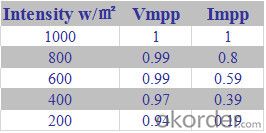
Soldering Ability
- Peel Strength: > 1.0 N/mm (Pull soldered ribbon from busbar in 5 mm/s of 180°)
Dimension Figure

Quick Response
- Any time and anywhere, reply clients' email and solve all problems happen in the work at the first time.
- Remove clients doubts and offer the best solution at the first time.
- Give our clients the lastest news of the photovoltaic, update the newest stock informtion.
Production and Quality Control
- Precision cell efficiency sorting procedures
- Stringent criteria for color uniformity and appearance
- Reverse current and shunt resistance screening
- ISO9001,ISO14001 and OHSAS 18001,TUV Certificated


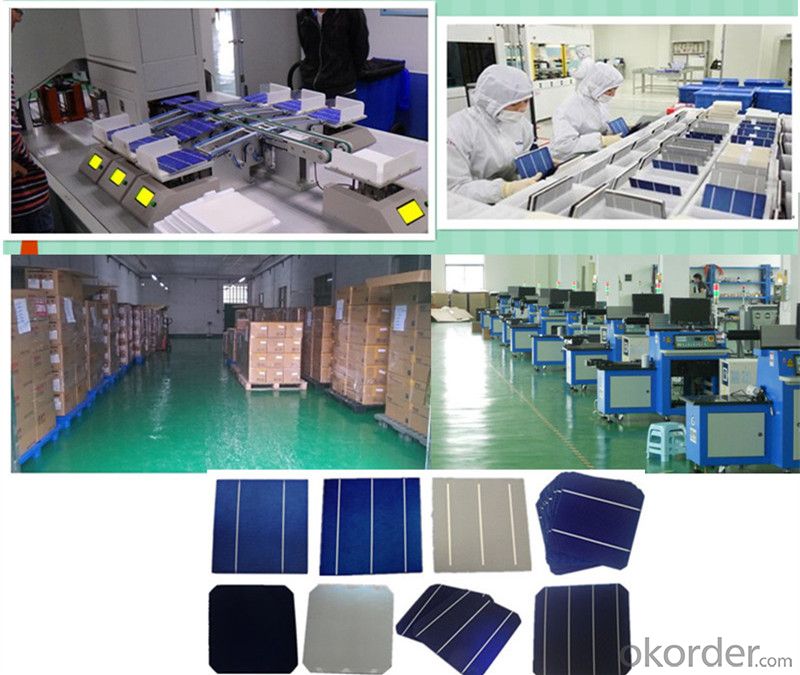
FAQ:
1. Q: Do you have your own factory?
A: Yes, we have. Our factory located in Jiangsu
2. Q: How can I visit your factory?
A: Before you visit,please contact us.We will show you the route or arrange a car to pick you up.
3. Q: Do you provide free sample?
A: Commenly we provide paid sample.
4. Q: Could you print our company LOGO on the nameplate and package?
A: Yes, we accept it.And need an Authorization Letter from you.
5. Q: Do you accept custom design on size?
A: Yes, if the size is reasonable.
6. Q: How can I be your agent in my country?
A: Please leave feedback. It's better for us to talk about details by email.
7. Q: Do you have solar project engineer who can guide me to install system?
A: Yes, we have a professional engineer team. They can teach you how to install a solar system.
- Q:What is the typical lifespan of a solar silicon wafer?
- The typical lifespan of a solar silicon wafer can vary depending on various factors, such as the quality of the wafer, manufacturing processes, and environmental conditions. However, on average, a well-maintained and properly installed solar silicon wafer can last for around 25 to 30 years.
- Q:How are solar silicon wafers protected from moisture during storage?
- Solar silicon wafers are typically protected from moisture during storage by being enclosed in airtight packaging or containers that are moisture-resistant.
- Q:Do solar silicon wafers require regular maintenance?
- Yes, solar silicon wafers require regular maintenance to ensure optimal performance and longevity. This includes routine cleaning to remove dirt, dust, and debris that may accumulate on the surface and hinder sunlight absorption. Additionally, periodic inspections and maintenance checks are necessary to identify and address any potential issues such as cracks, corrosion, or faulty connections. Regular maintenance helps to maximize the efficiency and lifespan of solar silicon wafers.
- Q:What is the thickness of a solar silicon wafer?
- The thickness of a solar silicon wafer typically ranges from 150 to 200 micrometers (µm).
- Q:How is the power output of a solar silicon wafer measured?
- The power output of a solar silicon wafer is typically measured by exposing it to a known intensity of light and recording the current and voltage produced. This measurement is conducted using a device called a solar cell tester or solar simulator, which simulates sunlight and provides accurate readings of the wafer's power output.
- Q:What is the impact of surface recombination on the performance of solar silicon wafers?
- Surface recombination refers to the loss of charge carriers (electrons and holes) at the surface of solar silicon wafers, which can significantly impact their performance. It leads to reduced efficiency and lower overall power output of solar cells. Surface recombination acts as a bottleneck for charge carrier transport, limiting their lifetime and diffusion length. This results in a decrease in the effective collection of generated charge carriers, reducing the conversion of sunlight into electricity. To mitigate this impact, various surface passivation techniques are employed to minimize surface recombination and enhance the performance of solar silicon wafers.
- Q:How are solar silicon wafers interconnected to form solar modules?
- Solar silicon wafers are interconnected to form solar modules through a process called solar cell stringing. In this process, multiple silicon wafers are connected in series using metal conductive ribbons. The ribbons are soldered onto the front and back contacts of the adjacent wafers, creating an electrical pathway between them. This interconnection enables the flow of current generated by the individual solar cells, allowing them to work together efficiently and produce electricity.
- Q:Can solar silicon wafers be used in solar-powered irrigation systems?
- Yes, solar silicon wafers can be used in solar-powered irrigation systems. These wafers are commonly used in solar panels to convert sunlight into electricity, which can then be utilized to power irrigation systems. By harnessing solar energy, these systems provide a sustainable and renewable source of power for irrigation, reducing reliance on traditional electricity sources and promoting eco-friendly farming practices.
- Q:What is the impact of wafer resistivity on solar silicon wafer performance?
- The wafer resistivity of a solar silicon wafer has a significant impact on its performance. Lower resistivity allows for better conductivity and reduces the amount of energy lost as heat during the conversion process. This results in higher efficiency and improved overall performance of the solar cell. Additionally, low resistivity helps in minimizing the series resistance, enabling better current flow and maximizing the power output of the solar cell.
- Q:How is a solar silicon wafer connected to other components in a solar panel?
- A solar silicon wafer is typically connected to other components in a solar panel through a process called soldering. Soldering involves using a soldering iron to melt solder, a metal alloy, and then applying it to the connections between the wafer and other components. This creates a strong electrical and mechanical bond, allowing for efficient transfer of electricity within the solar panel.
1. Manufacturer Overview |
|
|---|---|
| Location | |
| Year Established | |
| Annual Output Value | |
| Main Markets | |
| Company Certifications | |
2. Manufacturer Certificates |
|
|---|---|
| a) Certification Name | |
| Range | |
| Reference | |
| Validity Period | |
3. Manufacturer Capability |
|
|---|---|
| a)Trade Capacity | |
| Nearest Port | |
| Export Percentage | |
| No.of Employees in Trade Department | |
| Language Spoken: | |
| b)Factory Information | |
| Factory Size: | |
| No. of Production Lines | |
| Contract Manufacturing | |
| Product Price Range | |
Send your message to us
Mono Solar Cells156mm*156mm in Bulk Quantity Low Price Stock 18.4
- Loading Port:
- Shanghai
- Payment Terms:
- TT OR LC
- Min Order Qty:
- 1000 pc
- Supply Capability:
- 100000 pc/month
OKorder Service Pledge
OKorder Financial Service
Similar products
New products
Hot products
Hot Searches
Related keywords




















